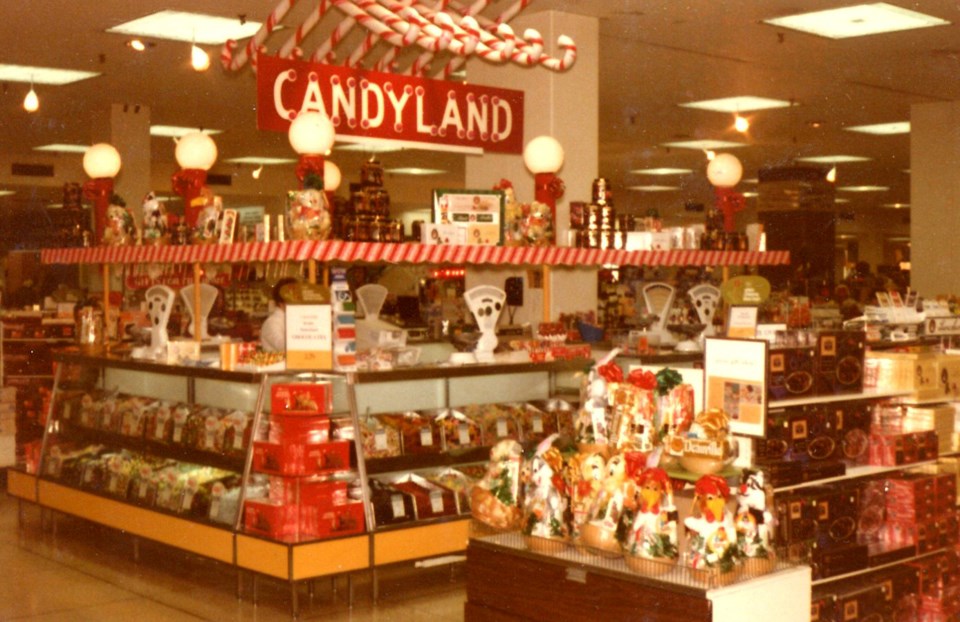IKEA Richmond recently unveiled a new line of products that used to be a sweet staple of local department stores.
Somewhere between the Billy bookcases and Poäng chairs, the Swedish retailer rolled out an in-store candy shop. Gummies, sours, marshmallows, chocolate and licorice are among the 48 candy varieties customers can scoop into a bag priced by weight.
It’s in keeping with the Scandinavian tradition known as Lördagsgodis, or “Saturday candy,” that gave children a green light to splurge on a bag of sweet stuff once the weekend arrived. It’s also reminiscent of the once gloriously inviting candy counter at Richmond Square’s old Sears department store.
At Sears, customers could buy chocolate and candy off the shelf, but bulk was best for sugar searchers. Employees armed with scoops would fill white paper bags to customers’ specifications: jelly beans, green mint leaves, gumdrops, soap candy, Chicken Bones, candy sticks, you name it.
Candy was kept behind glass counters and sold by weight, and customers could buy a little or a lot. Twenty-five cents of jujubes? No problem. Five Icy Squares? Sure.
Sears opened its first candy counter in the 1950s when the department store was known as Simpsons-Sears. In 1964 the Richmond store opened on No. 3 Road and its candy counter quickly became a destination.
Branded under the Country Inn name in its heyday — the same name Sears gave to its restaurants and cafeterias — the candy counter was sometimes a reward for kids whose parents dragged them along shopping. For others, like Karen Paulsen, visiting the Richmond counter was a special weekly event with her mom.
“Saturday was the day I just had to spend with my mom. She worked all week. One of the huge highlights was going to the candy counter,” said Paulsen, 45. “Every Saturday we went shopping together and that’s just what happened.”
Paulsen’s favourite was Swedish fish. Mom would buy Scotch mints.
After plastic replaced paper, mom kept an original Sears paper bag in her purse for new mints.
“When she passed, I carried that bag in my purse for about four years until it was just destroyed,” said Paulsen.
“It was just the most special thing about going shopping — getting to go there and walk around.”
In the mid-1980s, Sears wanted to dedicate more space to its core products — fashion, cosmetics and fragrances, home decor — and non-traditional department store areas were phased out.
Departments dedicated to books, records, fabrics, pets and candy all began to disappear.
“At certain times of the year the candy department became an important hub of activity. But the other side of that was that they did not generate enough traffic outside of those times to warrant the space they took up all year long,” said Vincent Power, a Sears Canada spokesperson, in an e-mail.
Christmas was one of those busy times for the candy counter. Power remembers a particular demand for fruit cakes.
“We sold them for a very good price from a quality supplier and many customers found that the time to invest in making their own just wasn’t worth it when these tasted so good,” said Power, adding customers could buy them frosted or unfrosted—an important detail for Christmas cake connoisseurs.
After the candy counters disappeared, Sears worked with suppliers to continue selling candy at key times of the year, but gone forever were the glass counters full of colourful bulk goodies.
A year ago Sears shuttered the Richmond store altogether, although the company continues to operate a Sears Home store here and other Sears department stores elsewhere in the Lower Mainland.
Fond memories are nonetheless still with Paulsen — about shopping with her mother, about candy clerks who seemed to love their jobs and about the candy itself.
“I remember I always got Swedish fish, and since the candy shop has been gone, I have never found a Swedish fish like those Swedish fish,” she said.



